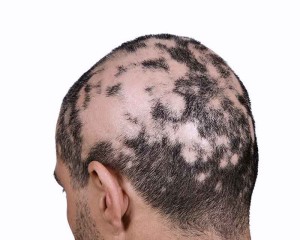Alopecia areata an autoimmune disease, in which the immune system is designed to protect the body from foreign invaders such as viruses and bacteria, mistakenly attacks the hair follicles, the structures from which hairs grow. This can lead to hair loss on the scalp and elsewhere.
In most cases, hair falls out in small, round patches about the size of a quarter. In some people, hair loss is more extensive. Although uncommon, the disease can progress to cause total loss of hair on the scalp (alopecia areata totalis) or complete loss of hair on the scalp, face, and body (alopecia areata universalis).

Causes
White blood cells attack the rapidly growing cells in the hair follicles. The affected hair follicles become small and drastically slow down hair production. Fortunately, the stem cells that continuously supply the follicle with new cells do not seem to be targeted. So the follicle always has the potential to regrow hair.
In those who are genetically predisposed, some type of trigger-perhaps a virus or something in the person’s environment brings on the attack against the hair follicles.
Effects
The effects of alopecia areata are primarily socially and emotionally disturbing. In alopecia universalis, however, loss of eyelashes and eyebrows and hair in the nose and ears can make the person more vulnerable to dust, germs, and foreign particles entering the eyes, nose, and ears.
Alopecia areata often occurs in people whose family members have other autoimmune diseases, such as type 1 diabetes, rheumatoid arthritis, thyroid disease, systemic lupus erythematosus, pernicious anemia, or Addison’s disease. People who have alopecia areata do not usually have other autoimmune diseases, but they do have a higher occurrence of thyroid disease, atopic eczema, nasal allergies, and asthma.
Treatment
There is neither cure for alopecia areata nor drugs approved for its treatment. Medications approved for other purposes can help hair grow back, at least temporarily. Although these treatments may promote hair growth, none of them prevent new patches or actually cure the underlying disease. In addition to treatments to help hair grow, there are measures that can be taken to minimize the effects of excessive sun exposure or discomforts of lost hair.
• Sunscreens are important for the scalp, face, and all exposed areas.
• Eyeglasses (or sunglasses) protect the eyes from excessive sun and from dust and debris when eyebrows or eyelashes are missing.
• Wigs, caps, or scarves protect the scalp from the sun and keep the head warm.
• An ointment applied inside the nostrils keeps them moisturized and helps to protect against organisms invading the nose when nostril hair is missing.
